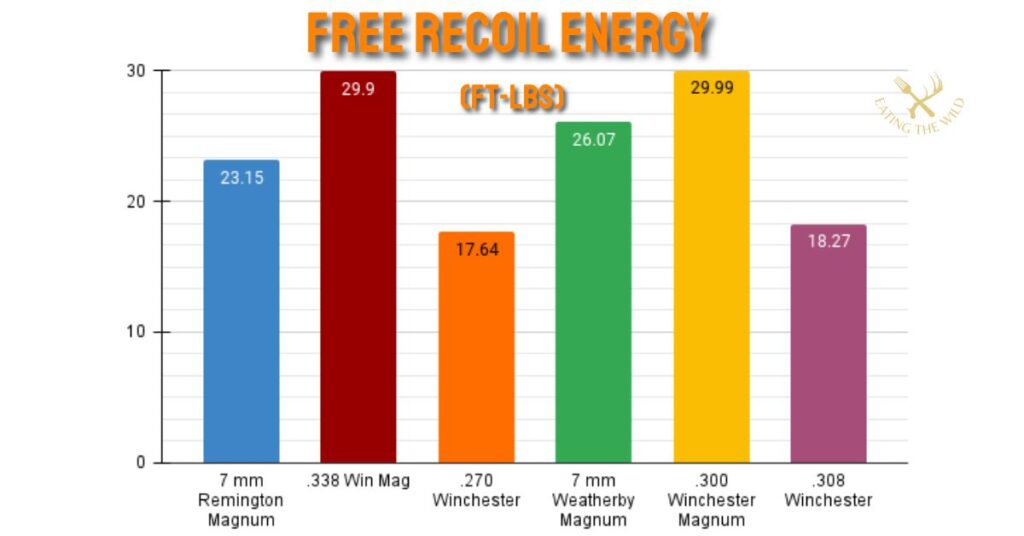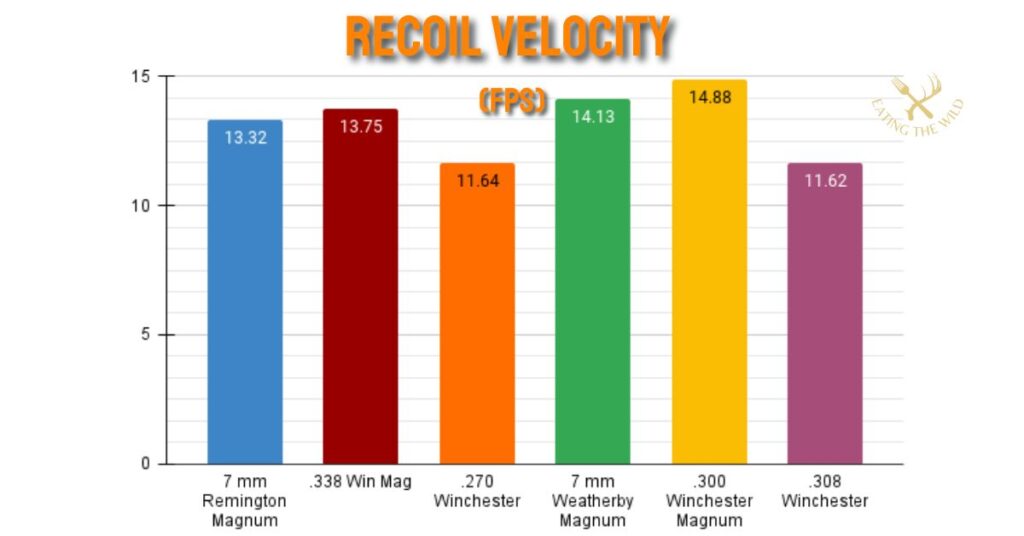The 7mm Remington Magnum cartridge has grown in popularity since its introduction in 1962. Originally crafted from the .375 H&H Magnum, the 7m Remington is in the belted cartridge family that includes a number of very popular magnum cartridges.
The reason Remington went with this belted cartridge design was meant to provide more precise headspace control.
Understanding the Technical Details
Before we start discussing recoil, we need to understand the basic technical data, especially the ballistics data associated with the 7mm Remington Magnum cartridge.
Since felt recoil is derived from the energy of driving the bullet down the barrel looking at the basic ballistics gives us a starting point.
This chart is based on shooting a factory-loaded 7mm Remington cartridge in a bolt action rifle with a 24-inch barrel. The cartridges were loaded with a 150-grain BTHP bullet.
Looking at this basic data gives us some understanding of the 7mm Remington Magnum. This is a relatively flat shooting cartridge.
At 400 yards, the 150-grain bullet delivers enough energy to ensure a clean and ethical kill on any of the large North American game animals. Past 400 yards, shot placement becomes much more critical on animals such as moose, elk, and brown bears.
The Matter of Felt Recoil

When we start considering felt recoil, it is important to understand how recoil works. Basically, the act of igniting the powder and forcing the 150-grain bullet down the barrel also forces the rifle backward toward the shooter.
This force has two components, the energy with which the force is applied and the speed at which the force travels backward.
Felt recoil is a combination of these two factors. The force of the felt recoil is usually measured in Ft-Lbs. of energy. The velocity of the recoil is measured in feet per second.
To grasp how these two measurements work in combination to create felt recoil let’s look at some examples.
High Force with Low Velocity
If you apply a lot of force to your shoulder slowly, it doesn’t begin to affect you until the force gets very high. The gradual increase is easily managed as it increases.
With recoil, a high level of recoil energy measures in ft-lbs. that is delivered at a very low velocity is easier to absorb by the shooter. The felt recoil, even at higher ft-lbs. is not as stressful.
Low Force with High Velocity
If we turn the conditions around, we can see the difference easily. If a blow to your shoulder is delivered very fast, but with a low amount of force, the felt effect is much different.
The speed at which the force impacts your shoulder is felt much more sharply and with less time to manage the impact.
Thus, even a relatively low amount of recoil force that is delivered sharply and rapidly is perceived to be a greater felt recoil.
Felt Recoil of the 7mm Mag Versus Other Popular Cartridges
It is hard to grasp the purely theoretical effect of felt recoil with some means of gauging those forces. Many of us have experience with different calibers and cartridges so a comparison of the 7mm Remington mag helps our understanding.
This chart lists the recoil energy and velocity of several popular cartridges.
Looking at the comparisons in this table we can make some general conclusions about the felt recoil of the 7mm Remington Magnum and the other cartridges in the comparison.
By and large, the 7mm Remington Magnum falls in the middle of the pack when comparing energy and velocity.
Both the .308 Winchester and the .270 Winchester deliver less recoil energy and at slower velocities than the 7mm Remington Magnum. That typically indicates that these two cartridges will deliver less felt recoil when conditions are similar.
The other cartridges all deliver significantly higher recoil energy at faster velocities. Remembering that higher energy and higher velocity mean more felt recoil, it is easy to surmise that these cartridges will have more intense felt recoil.
The Trade-Offs

Every cartridge and rifle choice involves some trade-offs and is a compromise. Things like distance, delivered energy, bullet ballistic characteristics, and the firearm are all factors that contribute to the choice of a cartridge and rifle.
When considering felt recoil, the 7mm Remington Mag offers a nice combination of delivered energy, flat shooting characteristics, and manageable recoil.
Having shot a 7mm Remington Magnum on several occasions both on the range and in the field, I find that the recoil is acceptable.
However, I would not want to take this rifle and cartridge to the range knowing I had to put a hundred rounds through the barrel.
In a case where I had the chance to hunt elk, moose, caribou, or brown bears, I would have no hesitation to select a 7mm Remington Mag. The felt recoil when factored with the ballistic characteristics and the need for delivered energy on target is a great compromise.
I don’t believe that there is a need to punish yourself unnecessarily by choosing one of the bigger magnum cartridges. What you shoot should be carefully matched to your quarry.
The 7mm Remington Magnum is used often to successfully and ethically kill all of the North American big game animals without suffering aching shoulders after taking a shot.
What Would I Choose?
Given the opportunity to hunt one or all of the Big Four in North America, the 7mm Remington Mag would have to be one of my top choices. This is especially true if I must hunt at a longer distance, or the target is considered dangerous if wounded.
When hunting smaller game such as white-tail or mule deer, I am sticking with my trusty Savage 110 chambered for .270 Winchester. I find the .270 to be less punishing than the 7mm Remington Magnum and more pleasant to shoot.








